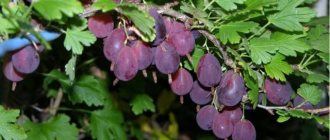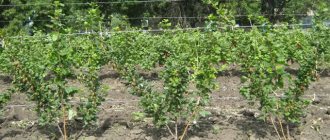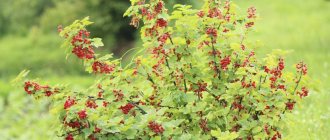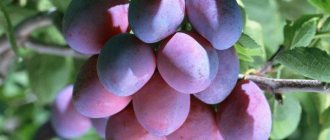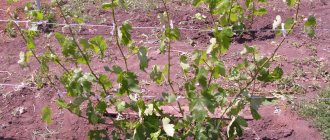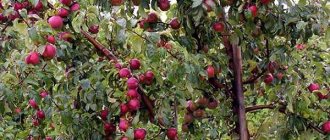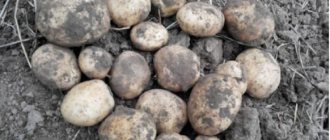History of selection
The variety is correctly called Masheka - in honor of the Belarusian noble robber who defended the poor. In Russia and Ukraine, this variety began to be mistakenly called Mashenka, which is why when searching for information about this variety, search resources simply do not show anything. The culture was developed by the Belarusian breeder A.G. Volzunev about 20 years ago.
Did you know? In English, gooseberry will be “goosberry”, which means “goose berry”. Most likely, the name is due to the fact that in the old days in Great Britain they made sauce for baked goose from gooseberries.
Description of the gooseberry variety Masheka
The gooseberry variety Masheka is zoned for the Central regions of Russia and the Volga-Vyatka region. According to gardeners, its winter hardiness makes it possible to grow berry crops from the northwestern regions to the Urals. This is a fairly universal variety for the middle zone.
Attention!
When choosing Masheka gooseberries, you need to remember that it is not suitable for arid regions, as well as for areas with short and cool summers. In such conditions, it is difficult to wait for a high harvest.
According to the description of the variety and photo of the gooseberry Masheka (Mashenka), it is a tall, medium-spreading bush. The central shoots grow predominantly upward, while the outer shoots may bend to the side. Young stems are flexible, gray-green in color, with smooth bark. The lower part may acquire a brownish-red tint. Over time they become rough. The color changes to gray-brown. The average height of the bush is 1.5-1.8 m.
The disadvantages of Mashek gooseberry include its thorniness. The thorns are single, rather sparse, formed mainly on adult shoots. But they are long, strong, located perpendicular to the stems. The color of the thorns is light yellow. On young branches, thorns are rare, mainly in the lower third of the shoots. They are less dangerous and do not interfere with harvesting.
The shoots are densely leafy, which gives the Masheka gooseberry a decorative appearance. The leaves are rich green in color and medium in size. Both five-fingered and three-fingered leaf blades are found. Distinctive features of the variety are pronounced wrinkling of the leaves, lack of pubescence, and their rounded edges.
Masheka gooseberry blooms with white and pink flowers of medium size. The center of the sepal is usually slightly greenish. The flowers are mostly cup-shaped and collected in paired inflorescences. But brushes of 4-6 buds are also often found.
According to descriptions of the variety and reviews of gardeners about Masheka gooseberries, the size of the berries largely depends on the cultivation conditions. The average weight of oval fruits is 3.0-3.5 grams. However, subject to the rules of agricultural technology and favorable weather conditions, they can reach 4-5 grams.
The skin of the berries of the Masheka variety is of medium density. At the stage of technical maturity – brick-red color. As it matures, it acquires darker brown shades. The photo of Mashek’s gooseberries shows a large number of veins on the light pink fruits.
Characteristics, description
Description of the characteristic features of plants and berries:
- the root system is powerful, consisting of several main tap shoots buried 50 cm into the soil, and many additional suction roots located at a depth of about 15 cm;
- the bushes are dense, spreading, have a decorative appearance, especially during the ripening period;
- average plant height - up to 1.5 m;
- shoots are powerful, thickened, grow obliquely, are colored light green, produce a large amount of basal shoots;
- There are thorns, but they are smaller in size than those of standard varieties and are colored yellowish-brown;
- the foliage is medium-sized, with a low shine, dark green, divided into 3 or 5 lobes, wavy along the edges, without pubescence, with a leathery structure;
- leaves sit on thin, long, slightly pubescent petioles, located at an angle of 45° in relation to the shoot;
- the flowers are small, collected in inflorescences of 2 pieces, anthocyanin coloring;
- medium-sized berries, 4 g each, colored orange-red, during the period of physical ripening they acquire a brick-red hue;
- the skin is thin but dense;
- The fruits are located along the entire length of the branches, planted very densely.
Video: gooseberry variety Masheka
Characteristics and description of fruits
The berries of this variety are orange-red, without edges, medium in size and oval in shape. At the highest stage of ripeness, the fruits become brick red. Their taste is sweet and sour, the pulp is very juicy, with a lot of seeds. Tasting score – 4 points out of 5.
Areas of use
Jams and compotes are made from gooseberry fruits, jams and confitures are made. However, they are most useful when fresh - they contain a lot of vitamins and microelements, which are destroyed during heat treatment.
Advantages and disadvantages
Giving preference in cultivation to one or another gooseberry variety, you need, first of all, to dwell in more detail on its pros and cons. Taking into account the weaknesses of the plant will allow you to better organize its care.
- The main advantages of Masheka gooseberries:
- high winter hardiness;
- excellent indicators of quantity and quality of fruits;
- versatility of crop application, possibility of transportation over long distances;
- decorativeness of bushes;
- high resistance to diseases and pests;
- self-pollinating.
- Disadvantages of Masheka:
- too much root growth;
- demands on lighting;
- intolerance to waterlogging of the soil - the plants begin to hurt.
Drought resistance, frost resistance
This crop is a drought-resistant plant - abundant watering is required only in the initial phases of the growing season (spring and early summer). It also shows high resistance to frost - it tolerates temperature drops down to -31°C. The vegetation is not susceptible to pests and diseases if cultivation practices are followed.
Productivity and fruiting
The bushes begin to bear fruit 3-4 years after planting. From one bush you can harvest 5-6 kg of high-quality fruits with a sweet and sour taste every year. With proper care, the bushes can consistently produce fruit for 16–20 years.
Important! To prolong the ability of a crop to produce a harvest, it is necessary to rejuvenate the bush every 6–8 years by pruning. Otherwise, the vegetation will stop producing berries by the age of 8–10.
Main characteristics of berries:
- titratable acidity 2.23%;
- sugar content 9.5%;
- dry matter 14.5%;
- ascorbic acid 36.5 mg/100 g;
- pectins 0.89%;
- phenolic components 330.5 mg/100 g.
Advantages and disadvantages compared to other varieties and hybrids
The main advantages of Masheka gooseberries over other varieties:
- frost resistance;
- good yield indicators (up to 6 kg of berries from one bush);
- self-fertility;
- transportability of fruits;
- strong immunity to many diseases and resistance to most pests.
This variety has few disadvantages. Despite its frost resistance, it develops and bears fruit better in warm climates. Unfavorable conditions during the season reduce yields and interfere with the growth of root shoots necessary for reproduction.
Landing
Before planting gooseberries, you need to choose the right planting time and find an area where the vegetation will feel most comfortable. After this, you can begin choosing planting material and pre-planting preparation.
Deadlines
Plants of the variety in question can be planted in the spring, before buds open, or in the fall, around mid-September. The planting date must be selected in accordance with the climatic conditions of a particular region. In the northern and central regions, it is better to carry out the manipulation in the spring; in the southern regions, the time of planting does not matter much.
Gooseberry varieties with an average ripening period also include Baltic, Yubilyar and Donetsk.
Choosing a suitable location
The area for cultivating the Masheka gooseberry variety must be selected taking into account lighting and the location of groundwater. So, the ideal location would be on the southern or southeastern side of the site, with groundwater at a depth of at least 1.5 m.
The quality of the soil does not matter, the main thing is that it has neutral acidity - within 5.5–7 pH.
It is important to ensure that the soil is sufficiently nutritious. For this purpose, preparation begins six months before planting the vegetation.
Pre-planting preparation at the site consists of the following activities:
- digging the soil - 30–40 cm;
- soil disinfection using 1% colloidal sulfur concentrate or copper sulfate;
- a week after the previous manipulation - sealing for each m² to a depth of 20 cm with 10 kg of sand, 20 kg of manure, 1 tbsp. l. superphosphate;
- if the soil is acidic, add 300 g of dolomite flour or 600 g of wood ash + 10 kg of sand, 1 tbsp. for each m². l. superphosphate;
- leveling the area using a rake.
Important! If the soil is highly acidic, fresh manure cannot be added to it. You can use compost or rotted manure.
Selection and preparation of planting material
A high-quality seedling is the key to high productivity in the future. It is better to buy planting material from specialized nurseries that provide complete information about the variety and provide zoned plants. Seedlings with an open root system and a closed one are available for sale (sold directly in the containers in which they were grown).
The first option is purchased only when planting is planned for the near future, since such planting material cannot be stored for more than 3 days. The second option can be purchased at any time of the year, regardless of the planting time.
The ground part of a bare-rooted seedling should consist of 3-5 shoots, up to 50 cm high, without foliage. The trunks of the shoots are erect, without signs of dryness, areas with uneven color and mold. The underground part of the vegetation should be lignified, gray in color, not overdried, and 25 cm long.
Seedlings with a closed root, on the contrary, should be well leafed, with a shoot height of up to 60 cm. In high-quality planting material, additional white roots will be visible on the soil surface. If the main core shoots of the rhizome are exposed, then the purchase should be abandoned, since the vegetation has already outgrown and has been in this container for too long.
About a day before planting, the seedlings are inspected, the shoots are cut off, leaving 3-4 strong buds on each. The root system is immersed for 12 hours in the “Kornevin” solution (1 tsp per 1 liter of water).
Planting scheme
Plants are planted according to a 1×1.5 m pattern. Holes are dug 65 cm deep, 55 cm in circumference, approximately 5–7 days before planting. The soil from the holes is mixed with 10 kg of compost and 200 g of wood ash. The pits themselves are filled to a height of 15 cm with gravel. After this, 15 cm of nutrient soil is laid and 10 liters of water are poured into the hole.
Step by step landing:
- Place the plant in the hole and straighten its roots.
- Align along the root collar - after filling the hole, it should be under the soil at a depth of 6 cm.
- Fill the hole with soil, lightly compact it in the tree trunk circle, and add 10 liters of water.
- Mulch the soil around the plants with compost or sawdust mixed with peat (1:1).
Subtleties of planting and agricultural technology
The variety is characterized by high productivity. Masheka will give its owners tasty and aromatic berries if you provide the bush with the necessary care and choose the right place for planting.
Where to place
To plant Masheka, choose a flat and bright place, protected from the winds. Groundwater should not lie closer than 1.5 m to the surface.
Masheka gooseberries are recommended to be planted on a level and bright place
The soil in the area for planting gooseberries should be slightly acidic, fertile and loose. If the soil is sandy or clayey, then it is recommended to plant the crop only after its preliminary improvement. A year before planting, you need to add 15 kg of organic fertilizers per 1 m2 to sandy soil (this can be humus, manure or compost), and add sand, in addition to organic matter, to clay soil. Experienced gardeners also advise adding 50 g of potassium sulfate and 40 g of double superphosphate per 1 m2.
Despite the fact that the culture tolerates the acidity of the substrate quite well, if its pH is below 5.5, then liming is necessary. The best fertilizer for this purpose is dolomite flour (application rate - 1.5 kg per 1 m2).
When and how to plant
Experienced gardeners advise planting gooseberries in the fall, about a month before the onset of frost. With such planting dates, the plant has time to take root well and withstand winter cold well. It is also permissible to plant Masheka seedlings in early spring before the buds open, but in this case the young gooseberries must be moistened abundantly.
In the selected area you need:
- Dig up the soil and remove all weed roots.
- Place the plants at a distance of approximately 1–1.5 m from each other.
Gooseberry seedlings should be placed at a distance of 1–1.5 m from each other
- Dig holes measuring 50x50x50 cm.
- Add 1 bucket of compost or well-rotted manure to the soil, as well as 40 g of potassium sulfate or 1.5 tbsp. wood ash, 100–120 g of superphosphate.
- Mix fertilizers with soil and fill the hole to a third of its volume.
- Cover the nutrient mass with ordinary soil and moisten it.
- Place the seedling in a hole without tilting and deepen it 5 cm more than it was grown before.
When planting, the seedling should be buried in the soil 5 cm more than it grew before.
- Cover the roots in the planting hole with soil without fertilizers, lightly compact the surface and water (0.5 buckets of water).
- Finally fill the hole with soil, make a hole around the seedling and water again (0.5 buckets).
- Mulch the hole with humus, peat or dry soil to reduce moisture evaporation.
- Trim all shoots, leaving 5–7 cm above the ground surface.
- Cover the cuts with garden varnish. This is necessary so that the young plant is not attacked by pests.
In the first years of life, seedlings develop slowly. First, the roots grow stronger, and only in the second half of summer the shoots begin to grow, and Masheka will produce the first berries in the 3rd year. Full fruiting of the gooseberry occurs when 15–20 strong and healthy branches are formed on it (in the 5th year of life).
Features of seasonal care
The culture is unpretentious in care. It is enough to follow the basic rules of agricultural technology and Masheka will delight the gardener with a bountiful harvest every year, without being affected by diseases and pests.
Soil care
When caring for plantings, the most important agrotechnical techniques are watering and aerating the soil. The first moistening is carried out at the end of April - beginning of May. For each m² of planting, 20 liters of water are added if the winter had little snow and there were no rainy periods in the spring.
Important! When the berries ripen, watering is carried out at least 1 week before harvesting. After picking the berries, the soil is not moistened for 2 weeks.
If the precipitation level is sufficient, then 10 liters for each bush will be enough. Then watering is carried out every 2-3 weeks, taking into account weather conditions.
The last time moisture is added to the soil is in mid-September (for the northern and central regions) or in mid-October (for the southern regions). At this stage, 20 liters of liquid are required for each m². This watering is one of the stages of preparing plants for winter.
After each watering and rain, the soil must be loosened a day later. This way you will be able to stimulate the supply of oxygen and properly distribute moisture in the upper and lower layers of the soil. In addition, this agricultural practice prevents the spread of diseases and pests, since most harmful microorganisms settle in the upper layers of the soil.
In the row-spacings it is necessary to loosen the soil to a depth of 15 cm, in the tree trunk circle to 7–10 cm. To retain moisture in the soil longer, after loosening it must be mulched. As mulch, you can use compost or sawdust mixed with peat (1:1).
Find out when gooseberries begin to bear fruit after planting seedlings, and how long a gooseberry bush lives.
Preventative treatment
The main prevention of diseases and pests is to follow the rules of agricultural technology regarding the procedure for moistening, soil care, fertilization and pruning.
If at the time of fruit set there is increased humidity in the air and soil, wood ash is not diluted in water, but dusted over the leaves and soil.
In addition, spraying should be carried out several times a season, which will help increase the immunity of plants and destroy microorganisms overwintering on the shoots:
- before buds open , use the drug “Emochka-Fertility” (1 tbsp per 10 liters of water), spray on shoots and soil;
- at the moment of formation of the ovary (strictly only after flowering, otherwise you will wash off the pollen) - spray a solution of wood ash (400 g of wood ash per 10 liters of boiling water, stir, cool, strain) on the leaf;
- in the fall, after moisture-recharging irrigation , spray the shoots and soil with 3% copper sulfate concentrate.
We also recommend that you try the Topaz fungicide for spraying gooseberries.
Feeding
During the first 2 years of growing gooseberries, no fertilizing is applied. The first fertilizer is given to plants for the 3rd year, in the initial phase of the growing season, i.e. before the buds open. At this stage, liquid mullein is used. It is diluted with water 1:10. Each plant requires 10 liters of ready-made working solution.
It is advisable to carry out the manipulation in parallel with watering. If you need to add 20 liters of liquid to each plant, then pour 10 liters of water into the trunk circle in the morning, and fertilizer in the evening. If the liquid requirement is 10 liters, then only fertilizer is applied.
The vegetation is fertilized a second time in the fall. Fertilizing should also be carried out in parallel with moisture-recharging irrigation. At this stage, fertilizers are applied in dry form. In the morning, watering is carried out, and in the evening, 90 g of superphosphate and 20 g of potassium salts per m² are planted to a depth of 10 cm.
Support
The bushes of the variety in question are of average height, so there is no need to organize trellises. But due to the fact that the shoots grow at an angle, they will droop greatly under the weight of the berries, so you need to install a support. There are special devices for this that you can buy or make with your own hands from wood. They have the shape of a cone or cube and are put on the plants immediately after planting.
Gooseberry support:
Trimming
One of the characteristic features of the crop is its rapid growth and the ability to form a huge amount of root shoots, which makes the plantings too thick. If you do not resort to formative pruning, diseases or pests will quickly multiply on the bushes, and the harvest will significantly lose in quality and quantity.
Did you know? Gooseberries contain a large amount of pectin, which helps remove radiation and toxins of various origins from the body.
The first stage of bush formation is carried out at the time of planting. The next pruning is carried out in the spring before the buds swell. If planting was carried out in the fall, then the second stage of formation is carried out the following spring.
Of the one-year growths, 2 should be left on each main shoot, shortened by 1/3, and all other branches should be cut into a ring. Of the root shoots, leave the 3 strongest ones, cut off the rest completely.
A year later, for each two-year growth, leave 2 strong shoots, shortening them by 1/3. Cut off all other branches and thin out the root shoots as in the second stage, leaving only the 3 strongest shoots.
When the bushes are formed, until the 6th year of life of the vegetation on the site, only sanitary pruning is carried out, which involves the removal of damaged shoots growing in the wrong direction, as well as root shoots. From the age of 6, you need to shorten all branches to 15 cm from the ground level.
When new growths begin to form, you must again carry out all the above-described manipulations to form the bush.
Gooseberry Mashenka: characteristics of the variety
Of course, the variety must be characterized based on the characteristic features and characteristics of the plant and berries. The plant's root system is very powerful and includes several key taproots that can extend about half a meter deep into the soil. There are also many small roots that are responsible for absorbing mineral components and substances contained in the soil. The bushes themselves are very decorative, especially when the harvest is almost ripe. On average, the plant can reach about one and a half meters in height, no more, but even for this the variety still requires some care.
The gooseberry shoots of the Mashenka variety are very powerful and thickened. They grow obliquely, not straight, and are colored an attractive light green shade. There are thorns on the plant, but they are very small, almost imperceptible. The foliage is medium in size, dark green in color and slightly shiny. When blooming, the flowers are small in size, they are collected in inflorescences of two, their color is anthocyanin.
As for the berries that appear on the bush, they are usually medium in size. The average weight of one berry is approximately 4 grams, and it is colored orange-red. The skin is very thin, but at the same time dense; when bitten, a characteristic bursting sound appears. The fruits are generally planted very densely, located along the entire length of the branch. This makes the bush very productive and prolific, which, of course, is an extremely positive feature of the plant.
The variety has some positive and negative traits and properties. The pros and cons also need to be mentioned, because these factors can significantly affect whether a gardener chooses this variety for cultivation or not.
The main advantages of the gooseberry variety Mashenka (Masheka) are as follows:
- this variety is very resistant to winter frosts, as well as to temperature changes and frosts in general
— the quantity and quality of the fruits are very highly valued by the gardeners themselves, who are engaged in growing the Mashenka variety
— the crop is very versatile, it can be moved over long distances, it will feel quite comfortable. The fruits will not lose their taste and external qualities and characteristics after transportation
- gooseberry bushes of the Mashenka variety, as we have already mentioned, are quite decorative
- the variety is resistant to diseases and pests, but it is still better to periodically take some preventive measures
— the variety is self-pollinating, so there is no need to plant shrubs nearby for pollination
There are also several disadvantages that we simply cannot help but mention. A huge amount of root growth is formed, which greatly complicates the processing of the area around the bush. The variety is also quite demanding in terms of lighting, but in general can tolerate partial shade. Waterlogged soil is the main enemy of a plant, as it can lead to the development of certain diseases, especially diseases of the root system.
Gooseberry Mashenka is a drought-resistant variety, and it requires watering only when the plant enters the active phases of the growing season. Basically, if we are talking about frosts, then the variety can tolerate a drop in temperature to an average of minus 31 degrees, without losing its capabilities and properties at all. The crop is also slightly susceptible to pests and diseases, fungi and viruses, but it is best for the gardener to follow all the rules of agricultural technology and cultivation of the variety. Only with the participation of the gardener himself can one obtain an excellent ornamental and, moreover, fruit-bearing plant.
Fruiting begins approximately in the third year after the shrub was planted in open ground. Every year, from one gooseberry bush you can collect about five kilograms of excellent fruits, which have excellent taste characteristics and can also be stored for a long time. If you properly care for the bushes, you can obtain fruits continuously for more than fifteen years.
Let us give several basic characteristics that relate directly to the fruits themselves. Their acidity is about two percent, and their sugar content is approximately 9.5%. The fruits also contain ascorbic acid, various dry substances, pectins, and phenolic components. They are very useful for the human body, for maintaining immunity and vital functions.
Harvesting and storage
The fruits do not ripen quite smoothly, but this is not a problem at all, since they do not fall off the branches for a long time. This makes it possible to harvest the crop in one go, immediately separating the berries
Check out
Benefits of gooseberries for humans: for diabetes, pregnant women, gout.
Collect the products together with the stalks by hand. Immediately put into wicker baskets or plastic boxes with low sides.
The bottom of the container is pre-lined with paper. At room temperature, the fruits remain fresh for 3 days.
At a temperature of +6°C and relative humidity, berries can be stored for up to 2 weeks without losing marketable quality and weight.
Nuances of care
To get a rich harvest of sweet and sour Mashek gooseberries, you should make a lot of effort. If you strictly adhere to the agrotechnical schedule, you can achieve high bush productivity for 18–20 years. The techniques that will allow you to achieve this result are quite simple and accessible to every gardener. This includes timely watering, fertilizing and formative pruning of the bush.
Water generously
Masheka gooseberry is declared by its creators as a drought-resistant plant, but it requires abundant moisture in spring and early summer. Sprinkler and drip irrigation are best suited for this purpose (if several plants are planted in a row on the site). Another great way to moisten the soil around the bush is to water in the grooves. For this:
- Dig small trenches around the bush within a radius of approximately 30–40 cm from the base.
- 20 liters of water are poured into each groove. There is no need to heat the water; gooseberry roots are not afraid of cold moisture.
- The moistened substrate must be mulched with dry grass, straw or sawdust.
In dry summers, more frequent and abundant watering is necessary (3–5 buckets for each bush).
It is recommended to stop moistening before the berries begin to ripen. Excess moisture during this period will prevent the fruit from gaining sugar content, as a result of which the berries will turn out watery and sour.
Abundant watering in the grooves is an excellent way to provide the gooseberry roots with the necessary moisture.
Another abundant watering should be carried out in the fall (20–40 liters for one gooseberry bush). The plant responds well to pre-winter moisture. The so-called moisture-charging watering will help the plant to easily withstand the winter cold.
We feed
Timely application of both mineral and organic fertilizers will maintain stable high yields and promote resistance to diseases to which the variety is susceptible.
- It should be noted that the nutrients added to the planting hole when planting a seedling will be sufficient in the first three years of the bush’s life. Then it is necessary in the fall, once every 2-3 years, to apply about 6 kg of organic fertilizers, 20 g of superphosphate and 1/2 cup of wood ash per 1 m2 for each gooseberry bush.
- In early spring, before the buds open, experienced gardeners advise feeding the crop with ammonium nitrate (15 g per 1 m2 for young bushes, 20–25 g for mature ones).
If there is an insufficient amount of nutrients, the leaves relatively early, even in the summer, acquire an unusual color (a colored rim along the edge of the leaf or purple or violet spots between the veins of the leaf blades). If you find such symptoms on a plant, immediately feed Masheka, since a healthy bush has dark green foliage.
Trim and shape gooseberries
Pruning helps to form a full-fledged bush, get large berries and maintain stable yields. The peculiarity of Masheka is that the variety forms a huge number of basal shoots, which is why the bush becomes thickened and the quality and quantity of berries decreases. In addition, their growth is delayed until late autumn and the ends of the growths do not ripen well. Fruit buds are laid on the shoots of the previous year, while the main berry harvest is concentrated on shoots of the 1st–2nd order of branching and 1–2-year-old fruit branches, where up to 3 large berries can form from one bud, while on older branches only one small fruit.
Proper pruning helps to form a full-fledged bush and produce large berries.
To make Masheka fruits sweeter and larger, proper formative and sanitary pruning should be carried out. The basic rules of the procedure are as follows:
- A year after planting the seedling in the fall, cut out the shoots at ground level, leaving the 3–5 strongest ones.
- In subsequent years, cut off all weak annual shoots (basal shoots), leaving 3-4 healthy branches.
- On mature bushes, remove any old branches that are not bearing fruit well.
- If there is good growth at the bottom of the old shoot, then cut off only the tip of the shoot above the branch.
- Remove all broken, depressed, weak and unproductive branches of any age.
It is recommended to prune bushes that are too thick, gradually, with partial rejuvenation of branches that do not have basal shoots.
Pruning is recommended in the fall
The formation of an adult plant (over 10 years old) has its own characteristics. When pruning such a bush:
- we remove all short annual shoots growing at the base. In this case, it is recommended to leave 3–5 well-formed branches in the lower tier;
- We cut off the tops of fruiting shoots to a well-developed side branch;
- branches that have stopped producing berries are completely cut out in the fall;
- in early August we pinch the tops of the skeletal branches by 5 cm. This technique allows us to stimulate the formation of flower buds and increase the winter hardiness of the crop.
Anti-aging pruning of mature bushes is carried out every 2-3 years.
Getting ready for winter
Masheka is a winter-hardy variety, but in regions with severe cold it requires additional shelter. To help gooseberries overwinter well, agricultural experts recommend water-recharging irrigation in late autumn. In winters with little snow, it is necessary to cover the bushes with snow and trample it around the gooseberries. A great way to preserve a snow shelter is to cover it with soil or sawdust.
Video: caring for gooseberries
Preparing for winter
The culture in question is a frost-resistant specimen. Requires shelter for the winter only in the northern regions, where the air temperature drops to -35°C and below. In such conditions, the bushes are hilled and mulched. Then cover with agrofibre.
Preparation for winter is necessary regardless of the growing region and consists of the following activities:
- moisture-recharging irrigation (20 liters of water per m² of planting);
- applying fertilizer in parallel with loosening (as described above);
- mulching the soil to a height of 5–7 cm with compost.
Gooseberry Masheka: resistance to pests and diseases
The gooseberry variety Masheka is quite resistant to diseases, however, with intense soil moisture, as well as other unfavorable conditions, the plants are affected by the fungus. Sometimes gooseberries suffer from powdery mildew, so preventive treatments and inspections must be carried out regularly. It is best to water the bushes with boiling water for prevention in early spring in order to destroy pests and spores of some diseases that survived the winter. In order to protect Masheka gooseberries, many gardeners use insecticides.
Reproduction methods
This variety produces a large amount of root shoots, which makes the task of reproduction easier. It is enough in the spring to dig up several of the strongest one-year or two-year growths, with 3-4 powerful buds, and plant them in a prepared area.
If all the root shoots are carefully cut out, then the bush can be propagated by cuttings and layering. To do this in the spring, the branch needs to be bent to the ground, pinned, and placed in a previously prepared trench, 3 cm deep. Throughout the season, water the buried branch.
You can use various growth stimulants such as “Kornevin”, “Fitosporin”, “Zircon”, according to the instructions. By the fall of next year, several layerings will have already formed on the pinned shoot. The branch should be separated from the mother plant. Dig up and divide into parts according to the number of cuttings obtained.
It is better not to plant these parts in the ground immediately, but to place them in peat containers. The soil for growing cuttings is formed from garden soil, peat, sand and compost (1:1:1:1). By spring you will have full-fledged healthy seedlings that can be planted in the prepared area.
Did you know? Gooseberry leaves contain coloring agents, so they can be used as a natural coloring agent in the food industry, for example, in the manufacture of mastic for cakes.
Gooseberry variety Masheka: planting and care
Gooseberry Masheka: photo of the variety
Masheka gooseberry is propagated by cuttings, layering or dividing the mother bush. It is most effective to propagate by root method, so wait for the bush to grow and boldly divide the root system. It is best to dig in the shoots in the spring, so that during the growing season they have time to become well established in the ground, and in the fall you can separate the cuttings and plant new seedlings.
It is important to remember that all measures for the propagation of Masheka gooseberries are best carried out in the spring, before the sap flow begins, so that the plant adapts normally to new conditions.
But it is best to plant Mashek gooseberries in open ground in the fall, so that the root system has time to adapt to new conditions before the onset of frost. And as soon as the first rays of the sun warm up in the spring, the seedlings will begin to actively develop without wasting time on adaptation. It is best to plant gooseberries in open sunny areas, groundwater should be low and there should be no drafts.
The gooseberry variety Masheka does not like stagnant moisture, remember this. In lowlands, the root system develops poorly and rots. And the plant does not have enough air. Before planting, you need to carefully examine the plants, remove the dried parts of the roots, and then soak them in a biogrowth stimulator. This variety of gooseberry loves fertile soils, but does not grow on sandy soils. It is best to fertilize the soil in advance. For this purpose, both mineral and organic fertilizers are used.
The hole is usually rectangular, approximately 50 by 50 cm. It is important to maintain the distance between the bushes, remember it should be at least one and a half meters. Before planting, the hole is filled with a mixture of minerals and organic matter, and then, straightening the roots, the seedling is placed there. After this, the hole is filled in and the tree trunk circle is compacted. It is advisable to mulch the top layer of soil so that moisture does not evaporate and the soil remains loose and well-structured.
In order to get a high yield of the Masheka gooseberry variety, you need to follow the rules of care. If you water, feed, prune the plants well, and also carry out preventive inspections, then already in the second year after planting you will be able to enjoy ripe berries.
If we talk about moisture, it should be noted that gooseberries of the Masheka variety love water. Therefore, it is simply necessary to water the bushes regularly. The soil should be moistened most intensively in spring and summer. But if precipitation falls regularly in your region, then there is no need to water the plant. But remember, it’s important not to overdo it here. Stagnation of moisture provokes the development of many diseases and also contributes to the formation of rot on the root system. Therefore, do not allow the soil to become excessively waterlogged.
As we have already noticed earlier, the basal shoots of the Mashek gooseberry are actively growing. Therefore, the bush must be pruned frequently. Otherwise, due to their density, the branches will not be evenly illuminated by the sun, and the air will simply circulate throughout the area. Because of this, fruits often begin to rot and plants become sick. Also carry out annual sanitary pruning. This is necessary so that only strong and strong shoots remain on the bushes. All damaged branches will need to be removed. Due to the fact that the gooseberry variety Masheka has rather large fruits, young bushes often bend to the ground under the weight of the berries. Therefore, gooseberries need to be tied up. Usually the support is installed along the outer edge of the bush, a wire or mesh is pulled between the wooden pegs, this will also make the harvesting process easier, all the berries will look right at you, in addition, they will be incredibly clean, and this is best done in the third year after planting .
Mineral, organic and complex fertilizers are used for feeding. It is best to add organic matter to the soil in the fall, and minerals in the spring. Gooseberry bushes are often sprayed with useful solutions; this is called the foliar feeding method. But this must be done before flowering begins. In order to prepare the plants for wintering, you can cover the root part with spruce branches or sawdust. Such a pillow will help the plant tolerate the cold more easily. In the most severe climatic conditions, it is recommended to bend the branches to the ground and cover them with agrofibre. It should be noted that before wintering it is also necessary to water the plants abundantly in order to protect the root system from freezing.
Diseases and pests
With increased air and soil humidity, vegetation may become infected:
- powdery mildew - treat the bushes with 1% Bordeaux mixture concentrate (consumption 2 liters per 1 specimen), having previously removed all infected parts of the plant;
- anthracnose - remove infected shoots and foliage, spray with “Fundazol” (10 g/1 l of water), about 2 l of working solution is used per plant;
- septoria - cut off all infected parts of vegetation, spray with “Skorom” (20 ml per 10 liters of water), this will be enough to treat 10 m².
Among the pests, the gooseberry caterpillar can settle on the plant in question. Dusting plants and soil with wood ash or tobacco dust will help eliminate it.
Masheka is perfect for growing in any region, as it has high adaptive qualities. Growing it will not be a hassle. And if the gardener carries out all agrotechnical techniques, then the variety will produce a large harvest every year for 20 years.
Reviews
I don’t like gooseberries without sourness. Mashenka looks like boiled potatoes sprinkled with sugar. There is a lot of sweetness, but it is somehow bland, without zest. Most likely I will get rid of the variety
Last season Mashenka fell ill with powdery mildew. I sprayed it with ash diluted in water (150 g per 5 liters), it helped, but not completely. Only the fungicide Fundazol helped.
One year Mashenka began to show purple spots across the leaves. I thought it was some kind of fungal disease, I started reading the forum, it turns out it was just a lack of nutrients. I fertilized with Agricola, the leaf became dark green again.
Gooseberry Mashenka is worth taking a closer look at. It is suitable for use by people who are allergic to red varieties of berries. Raw fruits are recommended for overweight; compotes and decoctions help with insomnia and bronchopulmonary diseases. It surpasses apples in terms of iron and magnesium content.
Reproduction
The variety lends itself well to propagation by layering. In early spring, the lower branches of a 3-5-year-old bush should be bent to the ground in a pre-dug trench. Strengthen the branch with a fork, sprinkle with earth. During the season, the cuttings are watered; by autumn, the finished seedlings can be transplanted to a permanent place.
In addition, propagation by cuttings and division of an adult bush is practiced. Methods are less common, but also effective.
An adult gooseberry bush should consist of 15-20 shoots of different ages.
History and description of gooseberry variety Grushenka
The first information about gooseberries appeared in the 13th century. There are only about 50 species in the wild. Most grow in Europe, northern parts of Africa and America, Asia. Only 3 species of wild gooseberries have been found in Russia. But even such a small natural diversity was enough for more than a thousand varieties of cultivated gooseberries to appear on the market by now.
Among the many varieties, I would like to highlight one domestic one with the affectionate name Grushenka. The place where he was born was the All-Russian Selection and Technological Institute of Horticulture and Nursery Growing.
Gooseberry Grushenka - an achievement of domestic breeders
The plant is medium-sized, slightly spreading and compact. But the bush is densely covered with bright green, slightly shiny foliage. The ability of the shoots to branch strongly helps the young plant to form a bush quite quickly.
Gooseberry Grushenka is a compact plant
Inflorescences consist of 2–3 flowers. The fruits will ripen quickly. During early ripeness, the dense skin of the berries is colored reddish. As it ripens, the color changes, acquiring rich purple tones. The average weight of the fruit is from 4 to 5 g. Some sources indicate eight-gram fruits. The size is not too large, but the number of berries is simply impressive. Mature branches and annual shoots are densely strewn with them along their entire length. Sometimes, due to the abundance of the harvest, no foliage is visible. The taste is pleasant, sweet and sour. The seeds are very small. Taster ratings range from 4.1 to 5 points.
Due to the unusual shape of the berries, gooseberries received such a beautiful name - Grushenka
Features of the variety:
- the absence of thorns on the shoots, which makes the variety very attractive in terms of harvesting;
- long life span: Grushenka is capable of bearing fruit annually for 20 years;
- Although Grushenka blooms quite early, the flowers and ovary do not suffer from return frosts.
Gooseberry variety Mashenka: description, photos, reviews
It’s impossible not to love gooseberries; they’re a berry that sets the mood. To obtain a high-quality harvest, gardeners have to work hard. A successful choice of variety in combination with the right agricultural technology will help you get an excellent harvest. Gooseberry Mashenka is not a common variety, but it has a lot of advantages that allow it to take an honorable place in your garden.

